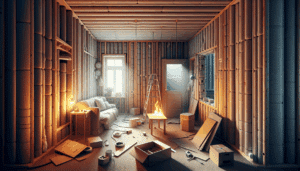Drywall is tough and hard but over time it will start to show signs of wear and tear. Fortunately, we at Utah Drywall & Repair can easily repair damaged drywalls. Here is what you need to do and avoid doing to repair a drywall.
Contents
Do # 1: Use the Right Equipment
When repairing dents and scratches that are smaller than half an inch, you should fill them with a thin layer of drywall mud, a type of joint compound. Use a three- or four-inch putty knife to smooth the filler until it is layered flush to the wall.
If your holes are larger than half an inch, you will need reinforced mesh to fix them. If you add drywall mud directly to larger gouges, it will not be sufficiently repaired and will crumble over time.
Do # 2: Work Neatly
Use a sharp blade to neatly cut mesh tape or frayed edges of the wallboard around cracks and holes before you apply the drywall mud. Otherwise, it will not have a smooth finish, will look bumpy from the outside, and will break away again in no time.
Do # 3: Layer Lightly
When it comes to drywall mud, you need to apply a light coat. Thin layers of putty are easy to sand and it will prevent the risk of removing thick and patchy drywall mud when you are sanding and exposing the patch again.
To make sure the layer is applied flush to the wall, you should apply it in a feathering motion. Holding the knife at a 70-degree angle, press the knife to the outer edges of the drywall mud as you move away from the center.
Do # 4: Use Protective Gear
When DIYing repairs, always make sure to protect yourself from injury and harm. Particulate from drywall can result in respiratory conditions and exacerbate allergies, so it is important that you always wear a dust mask. Also wear disposable gums to save your hands from dehydration caused by the gypsum.
Don’t No. 1: Don’t Damage Wires
Make sure that before you cut into a wall, there are no electrical wires or plumbing behind the wall. If the hole is small, use a flashlight to see what’s inside. You can also enlarge the hole to about an inch to see if there are cords or lines inside but do not go too deep or the damage to the wall may be severe.
Don’t No. 2: Don’t Cut Corners When Sanding
Make sure you slowly and steadily sand the repair site because if the finish is not smooth, the patch will appear very noticeable. Once the patch is dry, use fine-grit sandpaper to smooth it. After the first round of sanding, add another thin layer of drywall mud and spread it to about two inches beyond the parameters of the first patch. Re-sand the area.
Don’t No. 3: Don’t Forget Inspections
Make sure that you inspect the area thoroughly and find out if it has a smooth feel. Place your temple on the wall to detect any bumps and lumps in the area that may indicate it requires more sanding.
Once you are happy with the job, prime the area and paint it.
Although repairing a drywall seems simple, it requires a lot of skill and can take a lot of time and energy if you do not have experience in the job. That is why we recommend you hire a professional to do the job for you. At Utah Drywall & Repair, we can do the job for you in a fast, convenient and affordable way. Call us today at 801-406-6350.




